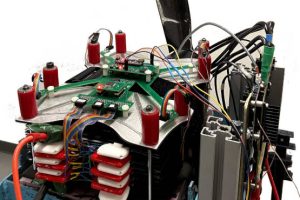University College London (UCL) is joining Space South Central, which is described as the UK’s largest regional space cluster. The university joins as another academic partner, it was announced at the Farnborough International Airshow. The University of Portsmouth, University of Southampton and University of Surrey are already involved in the cluster. “I’m delighted that UCL is joining the largest regional ...
Military/Aerospace Electronics
Electronics related to Military/Aerospace
UK Space Agency £10.9 million boost for Scottish space sector
The UK Space Agency is funding five Scottish space sector projects, to the tune of £10.9 million, it has announced at the Farnborough International Airshow. There are two larger scale projects involving a sub-orbital rocket test by HyImpulse UK from the SaxaVord spaceport in Shetland, and Spire Global developing technology to supply unique weather forecasting data. There are also three ...
ESA’s Earth Return Orbiter passes key testing milestone
The European Space Agency’s (ESA) Earth Return Orbiter – the first spacecraft that will rendezvous and capture an object in space, to bring the first Mars samples back to Earth – has passed a key milestone. The agency says the critical design review for the spacecraft’s platform has been completed, with the involvement of European industry partners and NASA. The ...
Gov spending makes global space economy worth $570bn
According to the latest report by the Space Foundation, the global space economy in 2023 is valued at $570 billion, an increase of 7.4% from 2022’s total of $531 billion. The US-based nonprofit organisation says – in its Space Report Q2 – that the growth is consistent with the industry’s five-year compound annual growth rate of 7.3%, with the space ...
Aircraft propulsion battery achieves 300Wh/kg
Magnix has designed a range of batteries for electric aviation. The first product of the line, Samson300, is focussed on maximum energy density, according to the company, achieving 300Wh/kg. A cycle life of over 1,000 full-depth discharge cycles is claimed. “Patented safety technologies include cell level protections from thermal runaway and ability to store batteries for long periods at zero charge,” ...
Jaxa teams with iQPS for on-orbit centimeter-level PPP demo
Jaxa is teaming with a Japanese company, iQPS, for on-orbit demonstrations that will estimate satellite orbital positions in real-time to centimeter-level accuracy. The Japanese space agency, has announced the joint research agreement as part of its Small Technology Innovation Satellite Research and Development Program. It will be partnering with iQPS (Institute for Q-shu Pioneers of Space) to enable a high-performance ...
University of Leicester space battery passes vibration tests
The University of Leicester is celebrating its progress towards developing a usable space battery employing radioisotope power technologies. Specifically, it highlights that its Radioisotope Thermoelectric Generator (RTG) has successfully completed its extreme vibration test campaign, proving the resilience that would be required for a rocket launch. Space battery The Space Nuclear Power group – a team at the University of ...
Maritime satellite comms to double by 2033
The maritime satellite communication market saw significant growth in 2023, according to ‘Prospects for Maritime Satellite Communications’, with Starlink boosting take-up of satellite comms for ships. Produced by the space consulting and market intelligence firm Novaspace – the result of a merger between Euroconsult and SpaceTec Partners – the release expects the market share of Non-Geostationary Orbit (NGSO) solutions as ...
ESA to launch AI satellite to show advances in Earth observation
The European Space Agency’s Φsat-2 mission is aiming to push the boundaries of AI for Earth observation. Due to launch in the coming weeks, the Φsat-2 satellite (pronounced PhiSat-2) is equipped with a multispectral camera and AI computing to analyse and processes imagery in real-time. The promise is for smarter and more efficient ways of monitoring our planet AI capabilities ...
High-power batteries for electric aviation
Subtle electrolyte changes can maintain power density in electric aviation batteries, according to the University of Michigan. While extended capacity retention is key for vehicle traction batteries, electric aviation demands power density retention from its batteries. “Both takeoff and landing require high power, and landing is more challenging because you’re not fully charged,” said Michigan engineering professor Venkat Viswanathan. “To ...
 Electronics Weekly Electronics Design & Components Tech News
Electronics Weekly Electronics Design & Components Tech News









